My Bulb Experiment: Three Years Later
May 2nd, 2023
I wish I could say that my experiment growing 955 spring bulbs of 16 kinds has been a rousing success, carpeting my yard with vibrant color at a time when most everything else is just waking up.
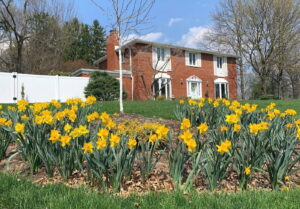
These ‘Mando’ daffodils have been my strongest bulb-trial performer.
But three years after planting, only four of my bulb groupings put on a good show this spring. The rest have dwindled into meagerness or disappeared altogether.
Read more on the bulb game plan and what got planted
To get right to the point, the four winners have been:
1.) Yellow-blooming ‘Mando’ daffodils, which have bloomed long and strong all three years from mid to late March in several front-yard beds. These are actually growing in number.
2.) Siberian squill ‘Spring Beauty’ (Scilla siberica), a low-growing blue-bloomer that’s spread and seeded its way into a colony on a morning-sun driveway terrace bed that later fills with astilbes, brunnera, sweet woodruff, and hydrangeas. These also bloom in mid to late March.
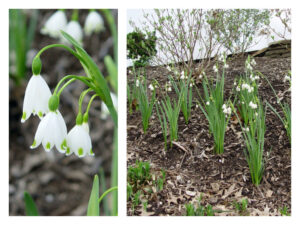
A 25-bulb planting of summer snowflakes ‘Gravetye Giant’ is thriving after three years.
3.) Summer snowflakes ‘Gravetye Giant’ (Leucojum aestivum), foot-tall plants that produce hanging, bell-shaped white flowers for about two weeks from mid to late April. All 25 bulbs I planted in another driveway-terrace bed are still growing, blooming, and steadily expanding.
4.) Camassia leichtlinii ‘Caerulea,’ a little-known, seldom-used bulb that grows about a foot tall and produces bluish-purple flower spikes in late April. The 25 bulbs of these also have come back reliably for three years now, despite deer gnawing off the foliage of this supposed deer-resistant species.
I should add here that I’ve had excellent results, too, with allium ‘Globemaster,’ a softball-sized purple bloomer that I planted four years ago (technically not part of this experiment).
And now, the losers.
Not surprisingly, I’ve had the least luck with tulips.
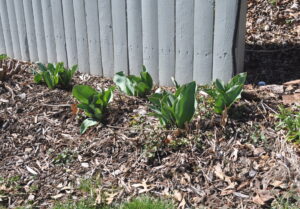
This cluster of tulips ‘Beauty of Spring’ is the best of what’s left after three years of tulip trials.
I planted four different kinds – including Darwin and Emperor types that are supposed to be among the best at “perennializing” – but all four dwindled sharply in year two and are down to a mere smattering in year three.
The experience only verified what I’ve heard and observed over the years, that tulips are best treated as one-year annuals. Public gardens such as Longwood and Hershey do just that by yanking their tulip displays each spring and planting fresh each fall.
Four other bulbs are complete goners in my yard three years after planting.
The biggest surprise among the losers was winter aconite (Eranthis cilicia). This little and very early yellow bloomer usually spreads into a dense carpet, sometimes growing a bit too aggressively for some gardeners.
Just the opposite happened for me. I planted 100 of them on a bank underneath a pair of oak trees. The first year was underwhelming, the second year yielded three or four scattered survivors, and this spring gave me just one little winter aconite flower.
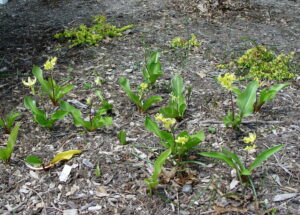
This is as good as it got for the ‘Pagoda’ trout lilies — the first spring. No sign of any now.
Also surprising was the quick and total demise of 25 trout lily ‘Pagoda’ bulbs. Trout lily is a native species that can be slow to establish but is supposed to ultimately spread into a foot-tall colony of lily-like yellow bloomers.
Only a handful of my 25 came up the first spring followed by none in year two and three.
The third disappointment was snakes head fritillary, also known as the “checkered lily” for its hanging, bell-shaped, early-April flowers that are a spotted cream and rose.
I planted 50 of these along a sunny front fence and 50 more in a kitchen garden of mixed flowers.
The kitchen-garden ones never materialized, while the front-fence ones put on a decent show the first spring. However, only a smattering came back in year two, while the show was over by year three.
The fourth no-show is crown imperial ‘Rubra Maxima.’ These are big, expensive bulbs that produce two-foot-tall plants with large, red-orange, crown-like flower clusters near the top of the flower stalks. I planted five of them on a sunny back bank.
Four of the five bloomed nicely the first year, but none came back after that.
The remaining bulbs I planted in the fall of 2020 aren’t gone altogether, but have been dwindling in number and/or flower power.
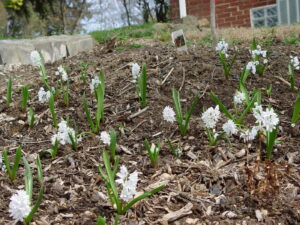
This is the striped-squill display in the first spring. Rather than filling in, it’s become sparser.
These include blue-and-white striped squill (Puschkinia scilloides var. libanotica), snowdrops ‘Hippolyta’ (Galanthus nivalis), hyacinth ‘Blue Jacket,’ and the white-blooming daffodil ‘Starlight Sensation,’ which was glorious in year one, good in year two, and sadly down to almost nothing this spring.
Read more on how each bulb planting fared in year one
So what went wrong?
I think it boils down to several explanations.
In the case of tulips, it’s just the nature of the beast. Most of them peak in a year or two, which is why growers (mostly in the Netherlands) each year plant new offsets, grow them under peak conditions for a full year, then sell the two-year-olds in their prime.
If Longwood can’t get tulips to reliably return year after year, that doesn’t bode well for “regular” gardeners.
A second pitfall is that a lot of bulbs are demanding about growing conditions. In particular, they don’t like clay soil or even occasional bouts with poor drainage. Those conditions cause bulbs to rot in the ground.
That spells trouble in so many of our yards, which feature heavy red or yellow clay and/or poorly drained “builder’s soil” left behind in the grading of home construction.
In my plantings, I avoided known wet spots and loosened my soil about a foot deep before planting.
Nevertheless, I suspect many of my no-shows resulted from rotting. My soil isn’t muck, but neither does it provide the “sharp drainage” that most bulbs want.
Apparently, some bulb types are more forgiving while others want the ideal – or else.
In other cases, I’m suspicious that some of my bulbs weren’t happy with its neighbors.
I planted the trout lilies, for example, around the base of a Kousa dogwood tree, given that this is a woodland species that prefers a bit of shade.
On the other hand, growers usually note that trout lilies aren’t OK with going completely dry in summer, when most spring bulbs are dormant and not affected by dry summer soil.
It’s possible the mature Kousa dogwood’s roots sucked up all the moisture in that bed, leaving the trout lily bulbs to shrivel and die.
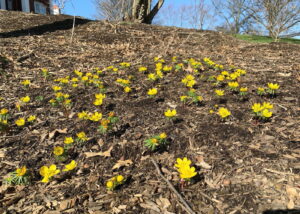
Winter aconite looked like this the first spring, but it’s possible that oak-tree-root competition choked them out of existence.
Roots could also explain the demise of my winter-aconite and snowdrop plantings. Both of these were planted in beds under and around a pair of mature pin oak trees.
The mere bulk of these roots could’ve out-competed the bulbs for nutrients and moisture, but I also wonder if there’s some allelopathy going on. Allelopathy is when one plant, in a move to defend its territory, puts out chemicals that stunt the growth of other plants.
Walnuts are the best known example of this kind of botanical defense, but many other species have allelopathic properties of varying degrees as well. Maybe pin oaks and winter aconite just don’t get along?
One last bulb pitfall is animal damage.
Assorted rodents (mice, voles, squirrels) dine on buried bulbs, while rabbits and deer are fond of some kinds of bulb foliage, flowers, and buds.
Tulips are the main target (everything seems to like the taste of them), while hyacinths, crocuses, and camassias are other somewhat common snacks.
Other than the camassia damage, I didn’t see any obvious signs of widespread animal destruction in my plantings.
Based on my three years of observing, here are five bulb lessons I’ve learned:
1.) Tulips are beautiful, but expect only one good year out of them… and even then, only when deer and rabbits aren’t lurking.
2.) Don’t trust your soil. It’s not enough to just loosen it. Work at least two or three inches of compost, rotted leaves, or similar organic matter into the loosened top foot of existing soil to create slightly raised beds.
While you’re at it, be careful not to bury bulbs too deeply. That also can encourage rotting. Plant so that the bottom of the bulb is two-and-a-half to three times as deep as its height, including any mulch you add over the soil. Example: plant a two-inch-tall tulip bulb with its bottom five to six inches below the level of the soil and mulch combined.
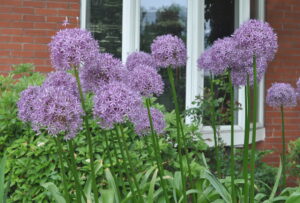
Alliums are some of the most animal-resistant plants. This is a grouping of ‘Globemaster’ along my front house foundation.
3.) If you know rodents, rabbits, and deer are around, stick with species they generally don’t bother, i.e. alliums, daffodils, Siberian squill, summer snowflakes, and snowdrops.
Otherwise, plan on using repellents and/or protecting beds with buried chicken wire.
Read more on how to keep animals from eating your spring bulbs
4.) Almost all bulbs seem to like full sun, superb drainage, and no competition from tree roots. Stick with those prime sites for best success.
Assuming your shade isn’t from nearby big trees, you might get away with Siberian squill, winter aconite, snowdrops, striped squill, and glory-of-the-snow (Chionodoxa), a little squill-like purplish-blue or pink bloomer that I didn’t trial this time but that yielded excellent results in my previous yard in Cumberland County.
5.) Don’t give up. Just because some bulbs don’t pan out, that doesn’t mean the whole group should be swept aside.
If you fail with tulips or hyacinths, try daffodils and alliums instead.
If snowdrops or striped squill fail under a tree, try a sunnier spot well away from any big roots.
If a planting of crocuses or summer snowflakes is going downhill, try lifting the survivor bulbs and replanting them in a raised bed that you’ve amended with several inches of organic matter. The best times to do this sort of “rescue” – right after spring dieback or in October, if you can find the bulbs when dormant without slicing into them.







